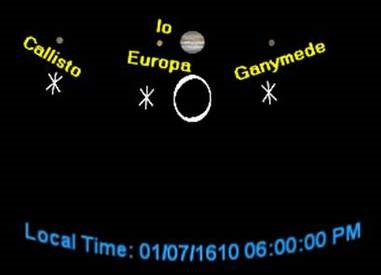
Jan 17, 2017 | History, Orbits, SciDome Tips, Time

Benjamin Franklin
Today is Benjamin Franklin‘s birthday under the calendar we use today, although he was born on the 6th of January of 1706. He was born before the Gregorian calendar reform was implemented in the English-speaking world.
The Gregorian calendar reform adjusted the way that leap years are counted. Instead of observing an intercalary day in February once every four years, the Gregorian observes one such day every four years except when the year is divisible by 100, except when the year is also divisible by 400.
The exact time it takes the Earth to go around the Sun 365.2422 days, not an integer number of days. During the Julian period the remainder was reduced from the 365-day year by adding a leap day every four years. However, the remaining error compounded. The Gregorian calendar uses 97 leap days every 400 years instead of 100 leap days, so the average length of the Gregorian year is 365.2425 days. The Gregorian change also ran a correction to delete the accumulated lag, which had grown to 10 or 11 days.
The new calendar came into force in Roman Catholic states in 1582.
Denmark switched to the Gregorian calendar in mid-February 1700.
The British Empire made the change in 1752.
For any celebrity birthdates you want to celebrate that are older than a certain limit and come from a certain country, it may be important to see if they should be read out as a Julian or a Gregorian date.
If you bring up Starry Night with a date of October 4th, 1582, and advance by one day, you can observe the 10-day correction when the Gregorian calendar was assumed.
The only alternative to observing the ten-day gap that followed in 1582 when looking at earlier dates is to use the proleptic Gregorian calendar, which eliminates the need for a Julian calendar correction when observing past dates. I wouldn’t recommend using the proleptic Gregorian calendar for earlier dates because the people of the time did not use it either, and Starry Night will read out those dates using the Julian.
By 1752, when the British Empire adopted the Gregorian, the accumulated error had grown to 11 days, and the change was reflected in the British colonies that later became the United States. Benjamin Franklin had already been publishing Poor Richard’s Almanac since 1733, and he included a long explanation of the calendar reform in the 1752 edition.
(When Abraham Lincoln used an almanac to show the phase of the moon during the Trial by Moonlight in 1858, as in our Fulldome Curriculum, he was taking a page from one of the most popular kinds of document in the English language other than the Bible.)
The calendar reform of 1752 didn’t catch everyone by surprise, and although the correction was run in September 1752, Franklin had adequate notice before his publication deadline the previous year. The British Parliament passed the new rule as the Calendar (New Style) Act 1750, although the code used for that legislation was “24 Geo. 2 c.XXIII”, meaning it was the 23rd piece of legislation that received royal assent in the 24th year of the reign of King George II. King George had commenced his reign in 1727.
The first point of the new law, before the Julian correction, was to correct the date of the beginning of the legal new year. Although different cultures have strong traditions to begin the new year on January 1st, even now it is impractical for all of our traditions to line up on a single start date: the school year and the NFL season being a couple of examples. The British Empire up to 1752 had observed the start of its legal year on March 25th. The law passed in 1751 corrected the New Year to January 1st at the beginning of 1752, so the official year 1751 was only 282 days long.
Starry Night does not incorporate any of the other weirdness around calendar reform, except that the new year always starts on January 1st, and there is a year Zero in between the BC and CE periods. (ATM-4 does not calculate a Year Zero).
Happy Birthday to Ben Franklin, who was not born on Blue Monday (It was a Sunday in both calendars, and the days of the week have never accumulated an error).

Oct 26, 2015 | History, Orbits, Planets & Moons, Scientific Method, Software, Solar System
Our ancestors were highly intelligent people who devised ingenious methods to model what they perceived to be reality in the skies. Unfortunately, they came at many of these observations with deep-rooted prejudices and a priori (preconceived) beliefs which shackled their creativity.

Figure 1: Close up of the Ptolemaic system out to the Sun’s sphere
The prevalent, far-reaching belief was that the Earth was immovable and at the center of the universe. Of course we know this is preposterous (even to the point that there is no such thing as a center to the universe), it is still a useful exercise to challenge students to prove, without leaving the Earth or using satellites, that the Earth does indeed rotate and that it revolves about the Sun.
Another a priori assumption was that celestial bodies never stopped moving, as opposed to “earthly” objects which eventually came to a halt. So, when the planets periodically went back and forth in the sky, this was unacceptable and Apollonius of Perga came up with a “solution” that allowed the wanderers to be always moving without stopping by coupling two motions at once. The planets were not simply attached to a mystical sphere (“deferent”) but they were actually attached to a mini-sphere (“epicycle”) which rotated on the larger one.

Figure 2: Mercury’s retrograde path in the Ptolemaic system
In this way planets could move around the sky but intersperse that generally easterly motion with apparent backwards motion (retrograde) when the transparent epicycle carried the planet backwards. The ancients latched on to it and it was greatly preferred to having deferents slow down, stop, go backwards, stop, then resume their original direction.
My colleague David Steelman and I created a program called Epicycles for SciDome that illustrates the main characteristics of the Ptolemaic Geocentric Model. It helps students discover the systemics of the model which can only be explained as “it just has to be that way”. Whenever that is the reasoning, it signals a problem with the theory/model. This will become obvious as we go through this paper.
Let’s first take a close look at the bodies closest to the Earth in the geocentric model, as shown in Figure 1.
The Moon moves the fastest in the sky (and even changes shape!) so it was assumed to be closest to Earth. Placement of Mercury and Venus closer to the Earth than the Sun was problematic. The theory was based upon the idea that those that appeared to move the slowest must be farthest away from Earth. The problem is that the epicycle containing Mercury, the epicycle containing Venus, and the Sun all orbited around the Earth in one year! So their order was reluctantly agreed upon because Mercury moved fastest on it epicycle, Venus next fastest, and of course the Sun had no epicycle (because it never retrograded).

Figure 3: Venus and Mercury’s retrograde paths in the Ptolemaic system
The epicycle sizes are based on arbitrarily assumed distances from Earth. The angles had to match the size of the retrograde loops seen in the sky so, looking at Figure 1, Mercury’s epicycle is tiny compared to Venus’ because Mercury’s retrograde loop is about 52 degrees in extent whereas Venus’ is about 92 degrees! The fact that Venus is farther away than Mercury from the Earth in this model requires it to be considerably larger than one might expect, but these are to scale to create the properly sized retrograde patterns.
As time is progressed a trace can be turned on which shows the retrograding patterns of the planets. Figure 2 shows a close up of Mercury and Figure 3 that of Venus.
When I ask students if they see anything peculiar as time progresses, eventually someone notices that the centers of the epicycles of Mercury and Venus are exactly and always lined up with the line connecting the Earth and Sun (the Earth-Sun Line). What explanation would the ancients have given for this? “It just has to be this way for this model to work.” Red flag number 1 that there’s something wrong with this theory.

Figure 4: The planets beyond the Sun’s sphere
Of course we know that in the Copernican heliocentric model we don’t need epicycles to cause Mercury and Venus to wobble back and forth around the Sun because they are simply closer to the Sun than Earth and they orbit the Sun. In fact, Copernicus was the first to completely untangle the motions of Mercury and Venus from the Sun’s motion.
This confusion is one rarely-discussed reason why the Copernican heliocentric model was so appealing. It unambiguously separated the motions of Mercury and Venus and even established, for the first time, their orbital periods around the Sun (88 days and 225 days, respectively).
Now observe the planets beyond the Sun, as shown in Figure 4. As we advance time another strange systematic displays itself, although this one is a lot more challenging to pick out. The Earth-Sun Line is always parallel to the planet’s epicycle radius! You can easily see this in Figure 4 now that you know to look for it.
Again, the ancients noted this “coincidence” but could never explain it other than “it has to be this way for the model to work.” Another red flag has raised itself in the flawed Ptolemaic model! The basic reason for this “coincidence” is because the retrograde motion of each planet is a function of its position relative to the Earth in its own orbit. Since we’re locking down the Earth and moving the Sun, it’s the orientation of the Earth-Sun Line that is the determining factor as to when planets exhibit their retrograde motions.

Figure 5 – The retrograde paths of the planets beyond the Sun’s sphere
When the planets leave breadcrumbs (see Figure 5) their retrograding paths become obvious. Again, the model has been carefully defined to accurately recreate the width of the retrograde loops as well as their frequency.
This is a fun and thought provoking lesson for my students because it demonstrates how intelligent and clever the ancients were in mimicking celestial motions, but it also shows how preconceived notions can weigh one down and severely complicate the model. It also clearly points out that when certain “features” of a model have no other explanation than “it has to be that way for the model to work” that the model is most likely flawed or incorrect at its core. But having the Earth move was a huge paradigm shift, and it took over 1500 years to overthrow it!

Nov 19, 2014 | Fulldome Curriculum, History, Orbits, Planets & Moons, SciDome Tips

Figure 1: Page from the original printing of Sidereus Nunicius showing Galileo’s sketches of the Medicean Moons
In many of our astronomy classes, we discuss the importance of Galileo’s first telescopic observations in eventually overthrowing the Ptolemaic geocentric system. His first observations were relayed to the public in his short book Sidereus Nuncius, which is Latin for The Starry Messenger (or arguably, The Starry Message). In it he relates his observations of the Moon, the myriad of new stars he observed (with sketches of the Pleiades and Praesepe regions), and the Moons of Jupiter.
He originally called these the Medicean Stars, a call out to his potential benefactors, the four Medici brothers (the book itself was dedicated to one of them who had been a former pupil). Seeking for funds for your science… things really haven’t changed very much in 400 years…
With Starry Night, SciDome can easily reproduce the date and situations of Galileo’s observations. Others have done this in the past, and I refer you to the excellent article by Enrico Bernieri called “Learning from Galileo’s Errors” published in the Journal of the British Astronomical Association, 122, 3 (2012) which goes through his observations in detail and discusses the errors which Galileo made.
Another excellent article is by Michael Mendillo in the Proceedings of the IAU Symposium No. 269 (2010) called “The Appearance of the Medicean Moons in 17th Century Charts and Books – How Long Did It Take?” which gives rich background on some of the aftermath of Galileo’s revelations.
I also highly recommend the Wikipedia article on Sidereus Nuncius as an excellent starting point in building your background information on Galileo’s first telescopic observations. In addition, Ernie Wright has graphically reproduced Galileo’s observations and placed them online in an excellent web presentation.
With the incredible talent of Steve Sanders (Eastern University Observatory Administrator), I have created a minilesson for Volume 3 of the Fulldome Curriculum which reproduces all of Galileo’s published observations of the Medicean moons.

Figure 2: SciDome presentation of Galileo’s first Jupiter observations from January 7, 1610 from Padua, Italy.
Using Padua, Italy as our observation location and the approximate times given for each observation in Sidereus Nuncius, we begin with the close-up view of Jupiter on the dome as seen on January 7, 1610 at approximately 6 PM local time. Next we place a slide of the view as drawn by Galileo in Sidereus Nuncius below the view to show just how accurate Galileo was in his sketches. The labels of the Galilean moons are then displayed.
Note that although all four moons presented themselves, Io and Europa were too close together to be resolved by Galileo’s homemade 20X telescope which suffered also from chromatic and spherical aberration. This is an important fact to remember, because essentially all of the “errors” which we will find in comparing his sketches to the actual viewing circumstances were because of his lack of resolution.
We proceed by advancing time in Starry Night so that the audience can watch the dance of the moons around Jupiter and stop at the next observations of Jupiter as recorded by Galileo, on January 8, 1610. Then his sketch of this configuration is displayed, and again we note the accuracy of his rough sketches.
The minilesson continues in this fashion, showing the moons moving from date to date and then presenting 21 successive sketches by Galileo as presented in Sidereus Nuncius. Galileo concluded after four nights of observations that these tiny “stars” were indeed most likely satellites of Jupiter, which was of momentous importance because it was the first time that moons had been discovered around another body.
It also indicated that a planet could move and moons “stay up with it” despite its motion, an Aristotelian argument once offered to discount that the Earth could be moving because, if it did, how could the Moon know enough to keep up with it? Obviously Jupiter had at least four moons and they had no problem staying with it!
I have found that going through many of these configurations with my students greatly enhances their appreciation of Galileo and the great discoveries that he made despite the limitations of his equipment. Presenting this minilesson engages students in the realization that Galileo was both an excellent and honest observer as well as a genius. His observations helped to lead to the downfall of the geocentric universe and the eventual acceptance of the heliocentric model











